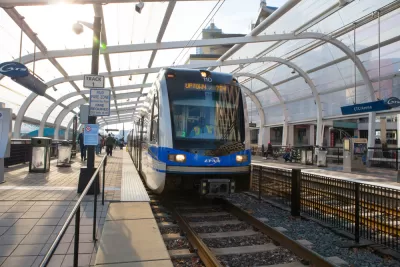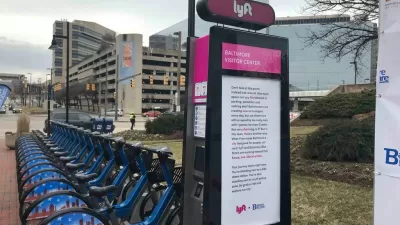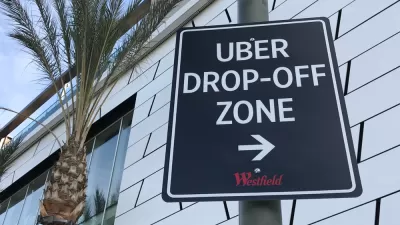A news report on Charlotte's Lynx Blue Line looks at whether ride-hailing services are complementing rail transit by providing vital first mile-last mile service or whether customers are forgoing the transit trip entirely. Ridership has been falling.

A March study by the American Public Transportation Association concluded that the two mobility providers, public transit operators and transportation network companies like Lyft and Uber, "are largely complementary," as are car and bike sharing services, all working together to enable a 'car-lite' lifestyle. However, a news report on Charlotte's gentrifying South End suggests that ride-hailing may be chipping away not only at bus ridership, but also potential passengers for the 9.6-mile light rail Lynx Blue line.
"For much of the past year, ridership on Charlotte Area Transit System buses and the Lynx Blue Line has declined," writes Steve Harrison for The Charlotte Observer. "For the first nine months of the fiscal year, ridership on all CATS services, including buses and the light rail, was down 4.3 percent compared with the same period a year earlier.
Just how much of that decrease can be placed on ride-hailing is unclear. Cheap gas and even broken counters on fare box machines may play a significant role.
Residents of transit oriented developments may prefer Uber
Another significant factor is that the gentrifying South End has displaced many transit-dependent residents. The new, all-market rate, transit-oriented apartments cater to millennials who don't appear to mind the higher ride-hailing costs and value their convenience.
Developers use the rail line as a marketing tool. For instance, the Fountains South End apartments has a first-floor Lynx Lounge, where people can wait inside a climate-controlled room before walking about 30 yards to the station.
Ridership on light rail in the South End, which opened in November 2007, has increased 30 percent since 2009 while population increased 135 percent.
Perhaps the most interesting part of Harrison's piece are his many interviews with area residents — all give high marks to Uber.
Raj Naik, general manager of Uber North Carolina, said the ride-hailing company has seen a significant increase in requests from South End, though he said it’s no greater than other parts of the city.
Partnering with Uber
It’s unclear whether companies like Uber are going to chip away at transit ridership – or whether CATS can partner with ride-hailing companies to make bus and train trips easier and grow ridership.
Earlier this year, CATS chief executive John Lewis said ride-hailing companies were a “challenge” for the transit industry, especially for trips on nights and weekends.
CATS said its plans to partner with ride-hailing providers are still “in the conceptual stage.”
SEPTA has already gone from conceptual to a summer pilot program in their partnership with Uber. Targeted are stations with oversubscribed parking. Subsidizing ride-hailing services could prove to be a competitive alternative to increasing parking.
"Under the partnership, Uber rides will be discounted by 40 percent to-and-from 11 suburban Regional Rail stations in Bucks, Chester, Delaware and Montgomery Counties, with a maximum discount of $10 per ride," notes the SEPTA May 25 press release.
The stations selected for inclusion in this pilot program are among SEPTA's busiest, with high ridership and limited availability of parking spaces. Several are key points for Airport travel, and others are at locations where parking is temporarily restricted due to construction.
However, it's questionable how transferable the findings from a commuter rail pilot program serving low dense areas will be with light rail serving Charlotte's higher density, transit-oriented South End.
FULL STORY: Some Charlotte residents jump on Uber over train in South End

Study: Maui’s Plan to Convert Vacation Rentals to Long-Term Housing Could Cause Nearly $1 Billion Economic Loss
The plan would reduce visitor accommodation by 25,% resulting in 1,900 jobs lost.

North Texas Transit Leaders Tout Benefits of TOD for Growing Region
At a summit focused on transit-oriented development, policymakers discussed how North Texas’ expanded light rail system can serve as a tool for economic growth.

Using Old Oil and Gas Wells for Green Energy Storage
Penn State researchers have found that repurposing abandoned oil and gas wells for geothermal-assisted compressed-air energy storage can boost efficiency, reduce environmental risks, and support clean energy and job transitions.

Santa Barbara Could Build Housing on County Land
County supervisors moved forward a proposal to build workforce housing on two county-owned parcels.

San Mateo Formally Opposes Freeway Project
The city council will send a letter to Caltrans urging the agency to reconsider a plan to expand the 101 through the city of San Mateo.

A Bronx Community Fights to Have its Voice Heard
After organizing and giving input for decades, the community around the Kingsbridge Armory might actually see it redeveloped — and they want to continue to have a say in how it goes.
Urban Design for Planners 1: Software Tools
This six-course series explores essential urban design concepts using open source software and equips planners with the tools they need to participate fully in the urban design process.
Planning for Universal Design
Learn the tools for implementing Universal Design in planning regulations.
Ascent Environmental
Borough of Carlisle
Institute for Housing and Urban Development Studies (IHS)
City of Grandview
Harvard GSD Executive Education
Toledo-Lucas County Plan Commissions
Salt Lake City
NYU Wagner Graduate School of Public Service





























